Business Resources Report: Analysis for Curry Lounge Business
VerifiedAdded on 2020/06/05
|12
|3593
|57
Report
AI Summary
This report provides an analysis of business resources, using Curry Lounge as a case study. It begins by outlining the recruitment documentation needed for a customer service manager role, detailing required skills like communication, problem-solving, and organizational abilities. It then explores employability, personal, and communication skills essential for various job roles, emphasizing their impact on workplace dynamics. The report also examines the main physical and technological resources crucial for a restaurant's operation, such as menus and kitchen equipment. Furthermore, it differentiates between internal and external sources of finance, including retained profit, personal savings, and shareholders. Finally, the report delves into the contents of a trading, profit and loss account, balance sheet, and the use of budgets for financial control, illustrating the overall financial state of a business. The report concludes with a summary of the key findings.
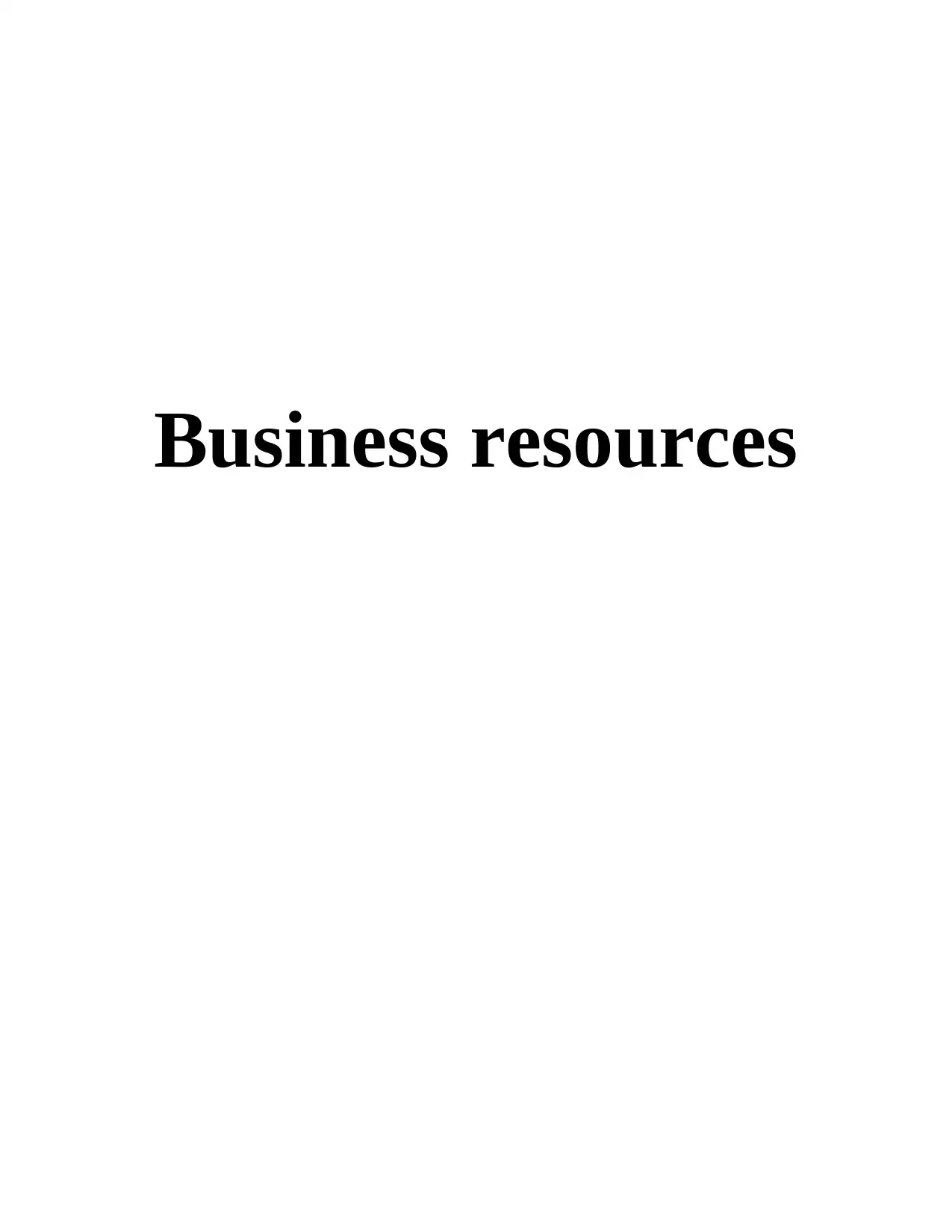
Business resources
Paraphrase This Document
Need a fresh take? Get an instant paraphrase of this document with our AI Paraphraser
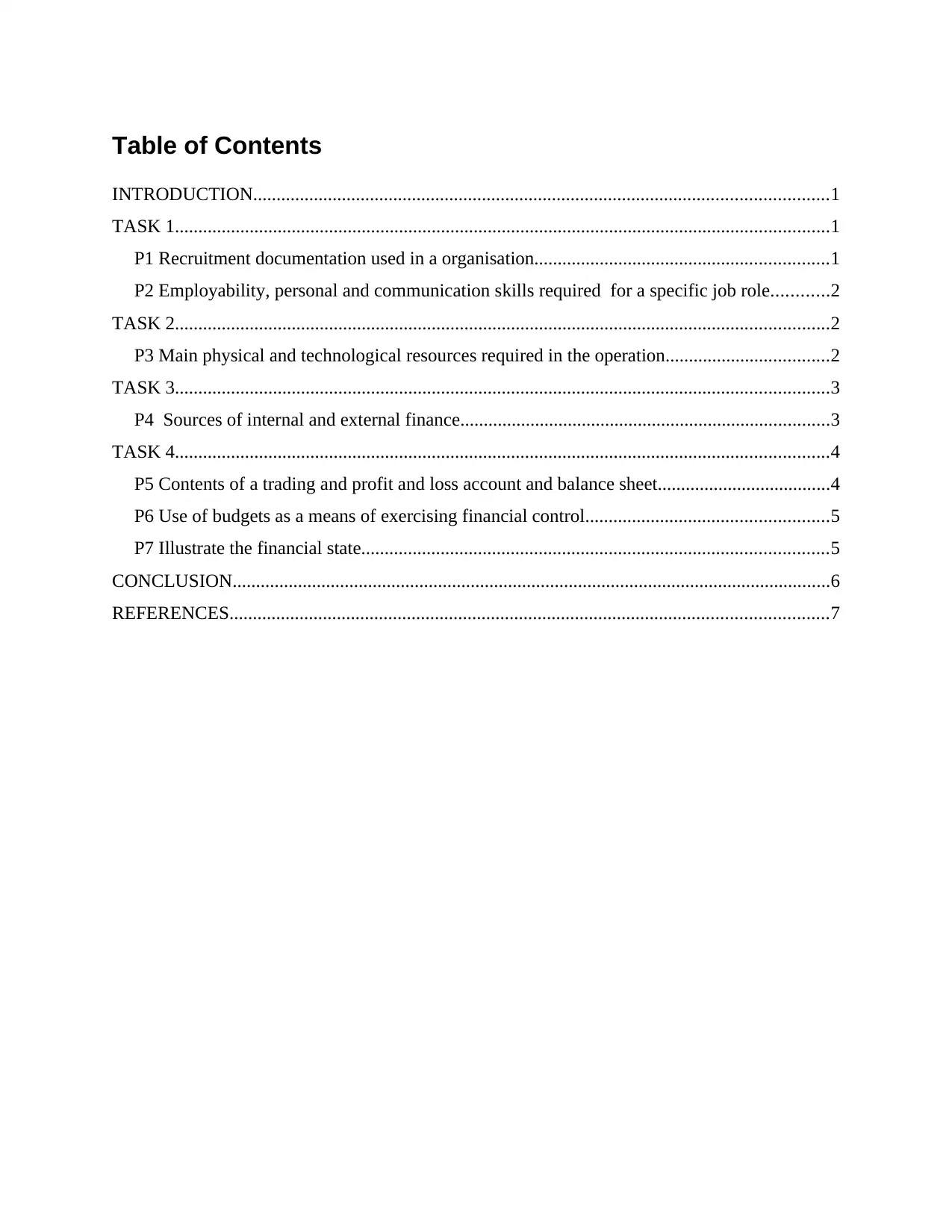
Table of Contents
INTRODUCTION...........................................................................................................................1
TASK 1............................................................................................................................................1
P1 Recruitment documentation used in a organisation...............................................................1
P2 Employability, personal and communication skills required for a specific job role............2
TASK 2............................................................................................................................................2
P3 Main physical and technological resources required in the operation...................................2
TASK 3............................................................................................................................................3
P4 Sources of internal and external finance...............................................................................3
TASK 4............................................................................................................................................4
P5 Contents of a trading and profit and loss account and balance sheet.....................................4
P6 Use of budgets as a means of exercising financial control....................................................5
P7 Illustrate the financial state....................................................................................................5
CONCLUSION................................................................................................................................6
REFERENCES................................................................................................................................7
INTRODUCTION...........................................................................................................................1
TASK 1............................................................................................................................................1
P1 Recruitment documentation used in a organisation...............................................................1
P2 Employability, personal and communication skills required for a specific job role............2
TASK 2............................................................................................................................................2
P3 Main physical and technological resources required in the operation...................................2
TASK 3............................................................................................................................................3
P4 Sources of internal and external finance...............................................................................3
TASK 4............................................................................................................................................4
P5 Contents of a trading and profit and loss account and balance sheet.....................................4
P6 Use of budgets as a means of exercising financial control....................................................5
P7 Illustrate the financial state....................................................................................................5
CONCLUSION................................................................................................................................6
REFERENCES................................................................................................................................7
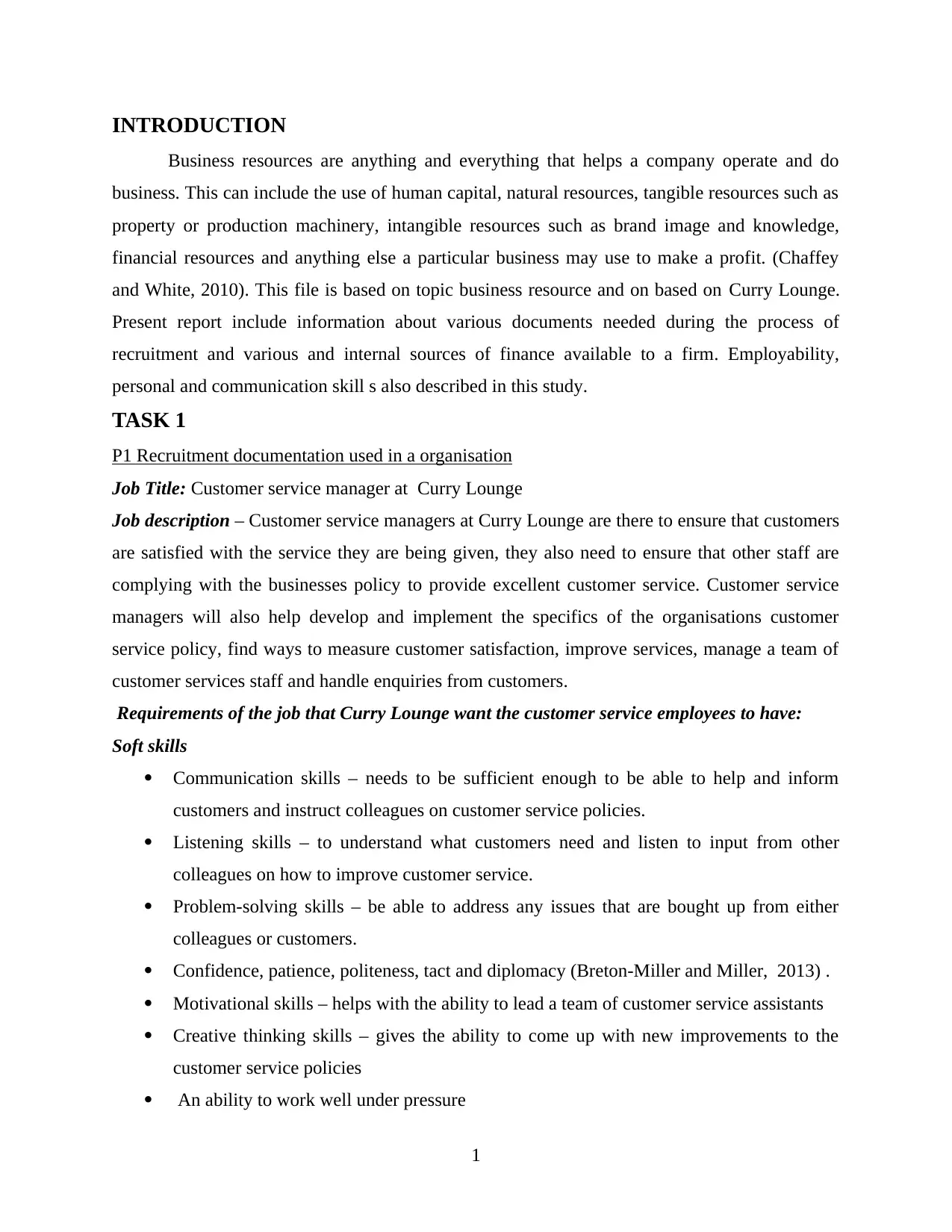
INTRODUCTION
Business resources are anything and everything that helps a company operate and do
business. This can include the use of human capital, natural resources, tangible resources such as
property or production machinery, intangible resources such as brand image and knowledge,
financial resources and anything else a particular business may use to make a profit. (Chaffey
and White, 2010). This file is based on topic business resource and on based on Curry Lounge.
Present report include information about various documents needed during the process of
recruitment and various and internal sources of finance available to a firm. Employability,
personal and communication skill s also described in this study.
TASK 1
P1 Recruitment documentation used in a organisation
Job Title: Customer service manager at Curry Lounge
Job description – Customer service managers at Curry Lounge are there to ensure that customers
are satisfied with the service they are being given, they also need to ensure that other staff are
complying with the businesses policy to provide excellent customer service. Customer service
managers will also help develop and implement the specifics of the organisations customer
service policy, find ways to measure customer satisfaction, improve services, manage a team of
customer services staff and handle enquiries from customers.
Requirements of the job that Curry Lounge want the customer service employees to have:
Soft skills
Communication skills – needs to be sufficient enough to be able to help and inform
customers and instruct colleagues on customer service policies.
Listening skills – to understand what customers need and listen to input from other
colleagues on how to improve customer service.
Problem-solving skills – be able to address any issues that are bought up from either
colleagues or customers.
Confidence, patience, politeness, tact and diplomacy (Breton‐Miller and Miller, 2013) .
Motivational skills – helps with the ability to lead a team of customer service assistants
Creative thinking skills – gives the ability to come up with new improvements to the
customer service policies
An ability to work well under pressure
1
Business resources are anything and everything that helps a company operate and do
business. This can include the use of human capital, natural resources, tangible resources such as
property or production machinery, intangible resources such as brand image and knowledge,
financial resources and anything else a particular business may use to make a profit. (Chaffey
and White, 2010). This file is based on topic business resource and on based on Curry Lounge.
Present report include information about various documents needed during the process of
recruitment and various and internal sources of finance available to a firm. Employability,
personal and communication skill s also described in this study.
TASK 1
P1 Recruitment documentation used in a organisation
Job Title: Customer service manager at Curry Lounge
Job description – Customer service managers at Curry Lounge are there to ensure that customers
are satisfied with the service they are being given, they also need to ensure that other staff are
complying with the businesses policy to provide excellent customer service. Customer service
managers will also help develop and implement the specifics of the organisations customer
service policy, find ways to measure customer satisfaction, improve services, manage a team of
customer services staff and handle enquiries from customers.
Requirements of the job that Curry Lounge want the customer service employees to have:
Soft skills
Communication skills – needs to be sufficient enough to be able to help and inform
customers and instruct colleagues on customer service policies.
Listening skills – to understand what customers need and listen to input from other
colleagues on how to improve customer service.
Problem-solving skills – be able to address any issues that are bought up from either
colleagues or customers.
Confidence, patience, politeness, tact and diplomacy (Breton‐Miller and Miller, 2013) .
Motivational skills – helps with the ability to lead a team of customer service assistants
Creative thinking skills – gives the ability to come up with new improvements to the
customer service policies
An ability to work well under pressure
1
⊘ This is a preview!⊘
Do you want full access?
Subscribe today to unlock all pages.

Trusted by 1+ million students worldwide
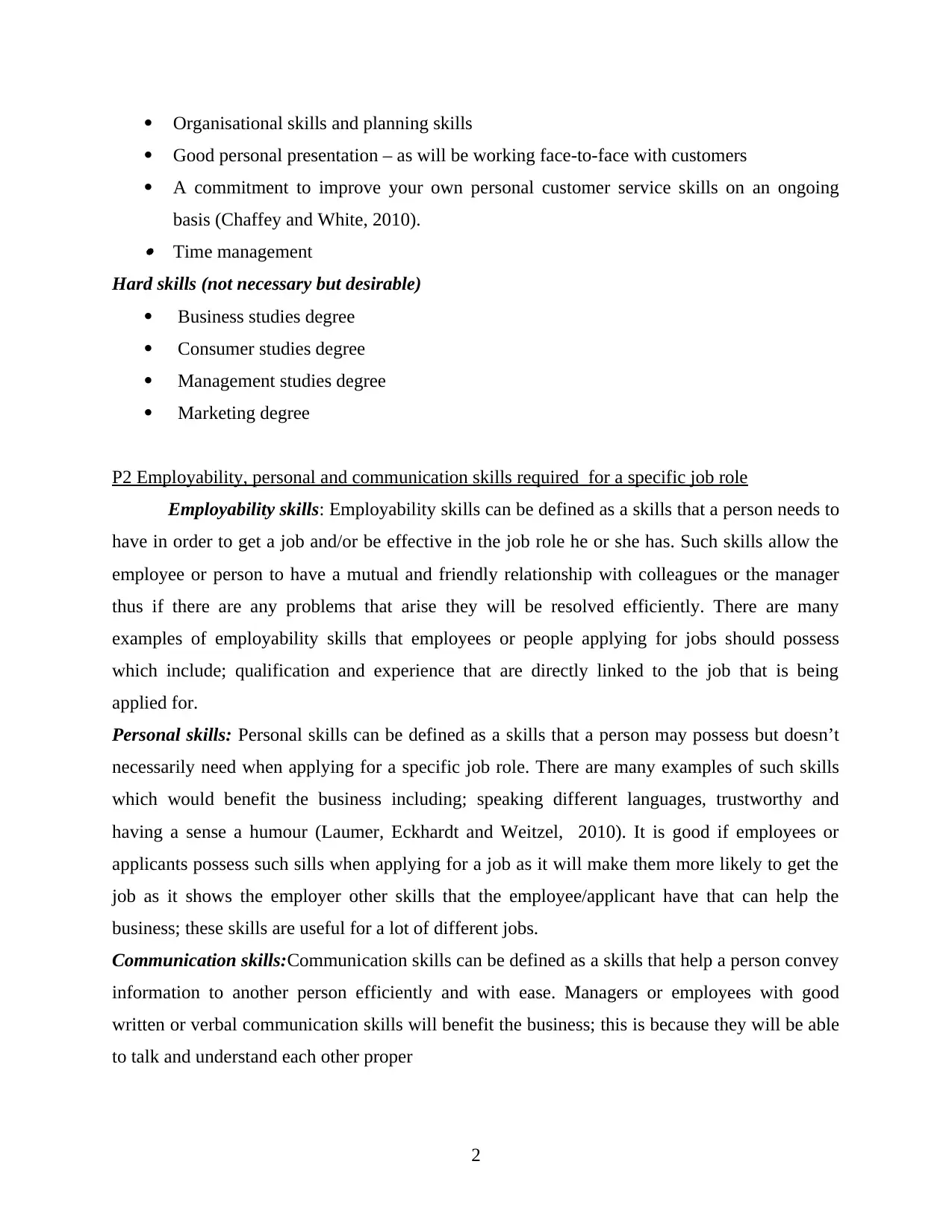
Organisational skills and planning skills
Good personal presentation – as will be working face-to-face with customers
A commitment to improve your own personal customer service skills on an ongoing
basis (Chaffey and White, 2010). Time management
Hard skills (not necessary but desirable)
Business studies degree
Consumer studies degree
Management studies degree
Marketing degree
P2 Employability, personal and communication skills required for a specific job role
Employability skills: Employability skills can be defined as a skills that a person needs to
have in order to get a job and/or be effective in the job role he or she has. Such skills allow the
employee or person to have a mutual and friendly relationship with colleagues or the manager
thus if there are any problems that arise they will be resolved efficiently. There are many
examples of employability skills that employees or people applying for jobs should possess
which include; qualification and experience that are directly linked to the job that is being
applied for.
Personal skills: Personal skills can be defined as a skills that a person may possess but doesn’t
necessarily need when applying for a specific job role. There are many examples of such skills
which would benefit the business including; speaking different languages, trustworthy and
having a sense a humour (Laumer, Eckhardt and Weitzel, 2010). It is good if employees or
applicants possess such sills when applying for a job as it will make them more likely to get the
job as it shows the employer other skills that the employee/applicant have that can help the
business; these skills are useful for a lot of different jobs.
Communication skills:Communication skills can be defined as a skills that help a person convey
information to another person efficiently and with ease. Managers or employees with good
written or verbal communication skills will benefit the business; this is because they will be able
to talk and understand each other proper
2
Good personal presentation – as will be working face-to-face with customers
A commitment to improve your own personal customer service skills on an ongoing
basis (Chaffey and White, 2010). Time management
Hard skills (not necessary but desirable)
Business studies degree
Consumer studies degree
Management studies degree
Marketing degree
P2 Employability, personal and communication skills required for a specific job role
Employability skills: Employability skills can be defined as a skills that a person needs to
have in order to get a job and/or be effective in the job role he or she has. Such skills allow the
employee or person to have a mutual and friendly relationship with colleagues or the manager
thus if there are any problems that arise they will be resolved efficiently. There are many
examples of employability skills that employees or people applying for jobs should possess
which include; qualification and experience that are directly linked to the job that is being
applied for.
Personal skills: Personal skills can be defined as a skills that a person may possess but doesn’t
necessarily need when applying for a specific job role. There are many examples of such skills
which would benefit the business including; speaking different languages, trustworthy and
having a sense a humour (Laumer, Eckhardt and Weitzel, 2010). It is good if employees or
applicants possess such sills when applying for a job as it will make them more likely to get the
job as it shows the employer other skills that the employee/applicant have that can help the
business; these skills are useful for a lot of different jobs.
Communication skills:Communication skills can be defined as a skills that help a person convey
information to another person efficiently and with ease. Managers or employees with good
written or verbal communication skills will benefit the business; this is because they will be able
to talk and understand each other proper
2
Paraphrase This Document
Need a fresh take? Get an instant paraphrase of this document with our AI Paraphraser
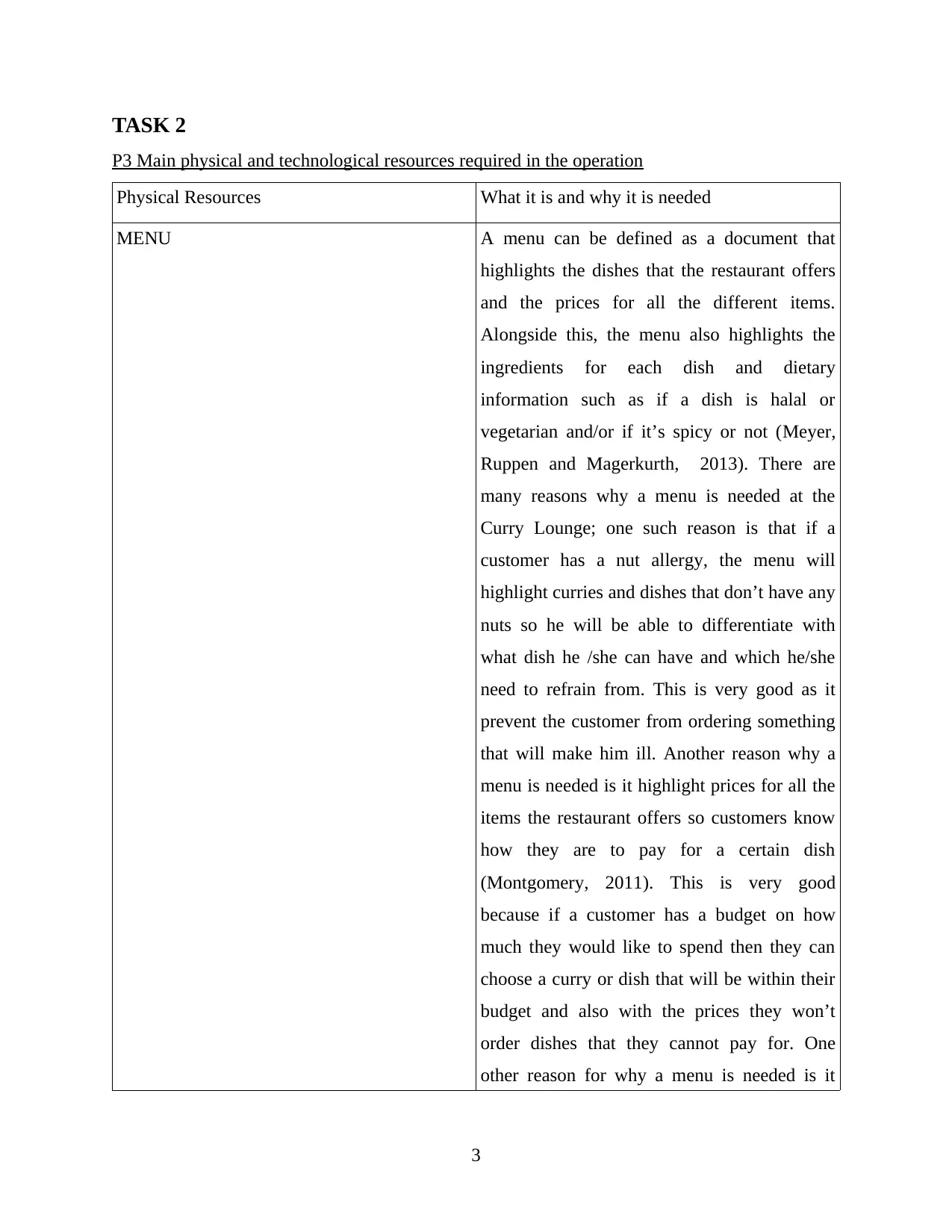
TASK 2
P3 Main physical and technological resources required in the operation
Physical Resources What it is and why it is needed
MENU A menu can be defined as a document that
highlights the dishes that the restaurant offers
and the prices for all the different items.
Alongside this, the menu also highlights the
ingredients for each dish and dietary
information such as if a dish is halal or
vegetarian and/or if it’s spicy or not (Meyer,
Ruppen and Magerkurth, 2013). There are
many reasons why a menu is needed at the
Curry Lounge; one such reason is that if a
customer has a nut allergy, the menu will
highlight curries and dishes that don’t have any
nuts so he will be able to differentiate with
what dish he /she can have and which he/she
need to refrain from. This is very good as it
prevent the customer from ordering something
that will make him ill. Another reason why a
menu is needed is it highlight prices for all the
items the restaurant offers so customers know
how they are to pay for a certain dish
(Montgomery, 2011). This is very good
because if a customer has a budget on how
much they would like to spend then they can
choose a curry or dish that will be within their
budget and also with the prices they won’t
order dishes that they cannot pay for. One
other reason for why a menu is needed is it
3
P3 Main physical and technological resources required in the operation
Physical Resources What it is and why it is needed
MENU A menu can be defined as a document that
highlights the dishes that the restaurant offers
and the prices for all the different items.
Alongside this, the menu also highlights the
ingredients for each dish and dietary
information such as if a dish is halal or
vegetarian and/or if it’s spicy or not (Meyer,
Ruppen and Magerkurth, 2013). There are
many reasons why a menu is needed at the
Curry Lounge; one such reason is that if a
customer has a nut allergy, the menu will
highlight curries and dishes that don’t have any
nuts so he will be able to differentiate with
what dish he /she can have and which he/she
need to refrain from. This is very good as it
prevent the customer from ordering something
that will make him ill. Another reason why a
menu is needed is it highlight prices for all the
items the restaurant offers so customers know
how they are to pay for a certain dish
(Montgomery, 2011). This is very good
because if a customer has a budget on how
much they would like to spend then they can
choose a curry or dish that will be within their
budget and also with the prices they won’t
order dishes that they cannot pay for. One
other reason for why a menu is needed is it
3
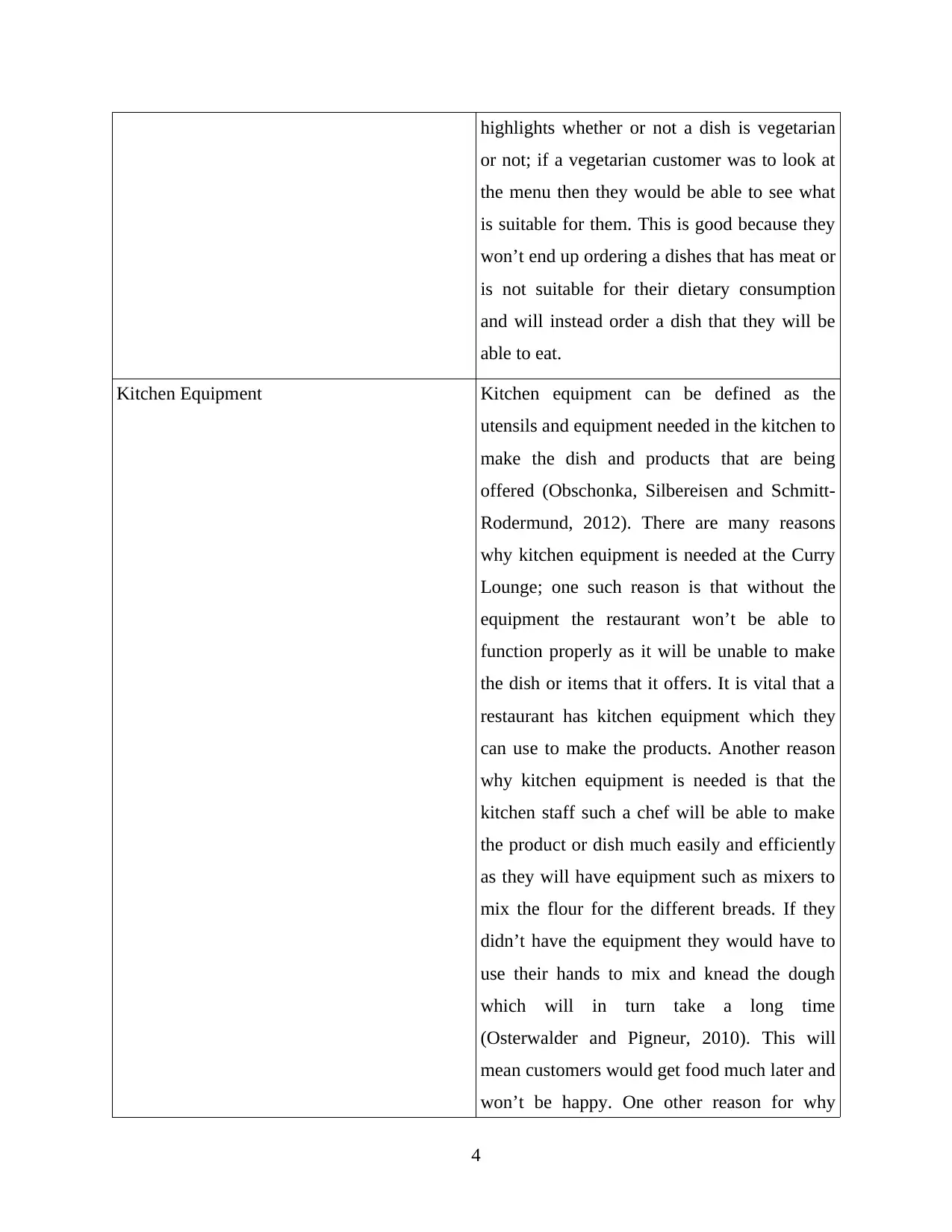
highlights whether or not a dish is vegetarian
or not; if a vegetarian customer was to look at
the menu then they would be able to see what
is suitable for them. This is good because they
won’t end up ordering a dishes that has meat or
is not suitable for their dietary consumption
and will instead order a dish that they will be
able to eat.
Kitchen Equipment Kitchen equipment can be defined as the
utensils and equipment needed in the kitchen to
make the dish and products that are being
offered (Obschonka, Silbereisen and Schmitt‐
Rodermund, 2012). There are many reasons
why kitchen equipment is needed at the Curry
Lounge; one such reason is that without the
equipment the restaurant won’t be able to
function properly as it will be unable to make
the dish or items that it offers. It is vital that a
restaurant has kitchen equipment which they
can use to make the products. Another reason
why kitchen equipment is needed is that the
kitchen staff such a chef will be able to make
the product or dish much easily and efficiently
as they will have equipment such as mixers to
mix the flour for the different breads. If they
didn’t have the equipment they would have to
use their hands to mix and knead the dough
which will in turn take a long time
(Osterwalder and Pigneur, 2010). This will
mean customers would get food much later and
won’t be happy. One other reason for why
4
or not; if a vegetarian customer was to look at
the menu then they would be able to see what
is suitable for them. This is good because they
won’t end up ordering a dishes that has meat or
is not suitable for their dietary consumption
and will instead order a dish that they will be
able to eat.
Kitchen Equipment Kitchen equipment can be defined as the
utensils and equipment needed in the kitchen to
make the dish and products that are being
offered (Obschonka, Silbereisen and Schmitt‐
Rodermund, 2012). There are many reasons
why kitchen equipment is needed at the Curry
Lounge; one such reason is that without the
equipment the restaurant won’t be able to
function properly as it will be unable to make
the dish or items that it offers. It is vital that a
restaurant has kitchen equipment which they
can use to make the products. Another reason
why kitchen equipment is needed is that the
kitchen staff such a chef will be able to make
the product or dish much easily and efficiently
as they will have equipment such as mixers to
mix the flour for the different breads. If they
didn’t have the equipment they would have to
use their hands to mix and knead the dough
which will in turn take a long time
(Osterwalder and Pigneur, 2010). This will
mean customers would get food much later and
won’t be happy. One other reason for why
4
⊘ This is a preview!⊘
Do you want full access?
Subscribe today to unlock all pages.

Trusted by 1+ million students worldwide
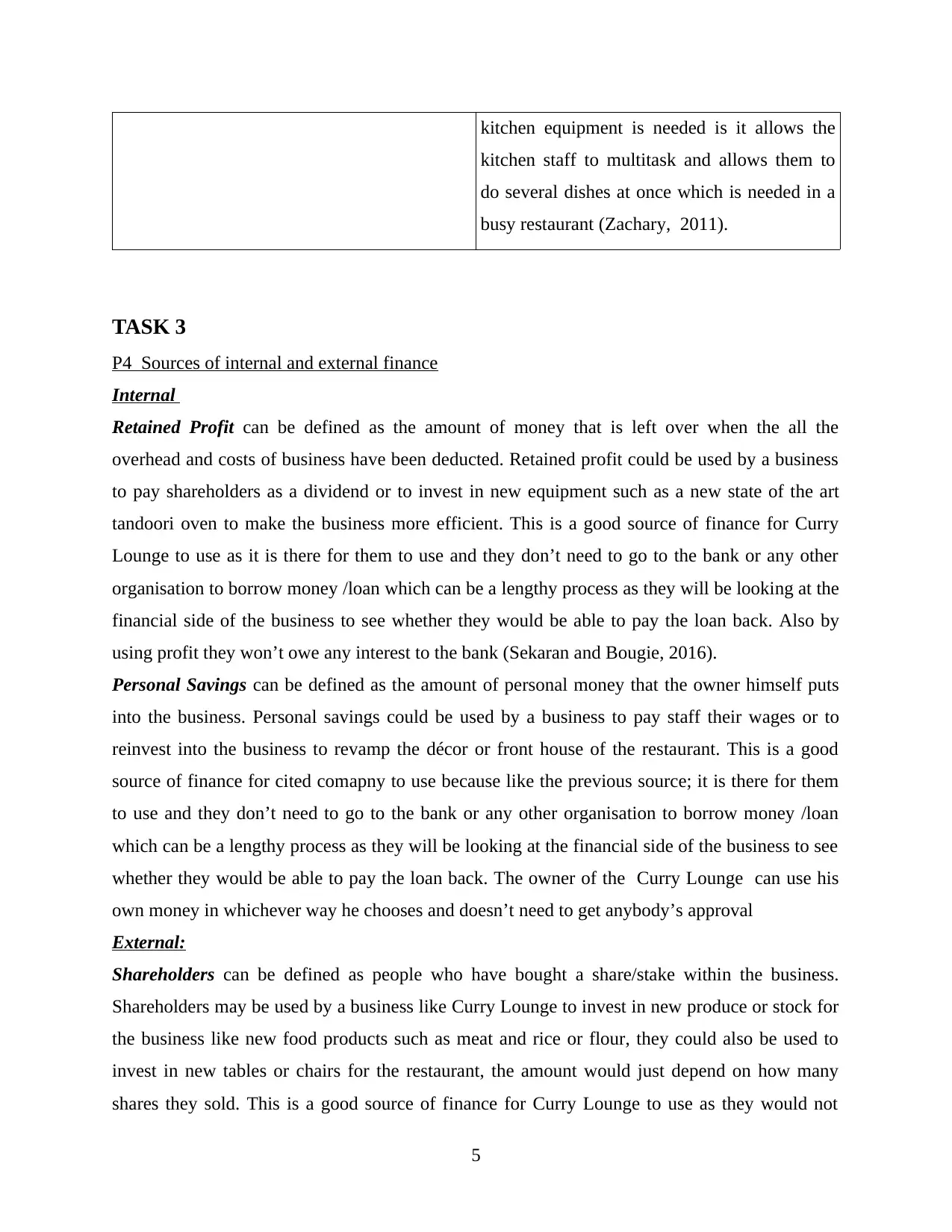
kitchen equipment is needed is it allows the
kitchen staff to multitask and allows them to
do several dishes at once which is needed in a
busy restaurant (Zachary, 2011).
TASK 3
P4 Sources of internal and external finance
Internal
Retained Profit can be defined as the amount of money that is left over when the all the
overhead and costs of business have been deducted. Retained profit could be used by a business
to pay shareholders as a dividend or to invest in new equipment such as a new state of the art
tandoori oven to make the business more efficient. This is a good source of finance for Curry
Lounge to use as it is there for them to use and they don’t need to go to the bank or any other
organisation to borrow money /loan which can be a lengthy process as they will be looking at the
financial side of the business to see whether they would be able to pay the loan back. Also by
using profit they won’t owe any interest to the bank (Sekaran and Bougie, 2016).
Personal Savings can be defined as the amount of personal money that the owner himself puts
into the business. Personal savings could be used by a business to pay staff their wages or to
reinvest into the business to revamp the décor or front house of the restaurant. This is a good
source of finance for cited comapny to use because like the previous source; it is there for them
to use and they don’t need to go to the bank or any other organisation to borrow money /loan
which can be a lengthy process as they will be looking at the financial side of the business to see
whether they would be able to pay the loan back. The owner of the Curry Lounge can use his
own money in whichever way he chooses and doesn’t need to get anybody’s approval
External:
Shareholders can be defined as people who have bought a share/stake within the business.
Shareholders may be used by a business like Curry Lounge to invest in new produce or stock for
the business like new food products such as meat and rice or flour, they could also be used to
invest in new tables or chairs for the restaurant, the amount would just depend on how many
shares they sold. This is a good source of finance for Curry Lounge to use as they would not
5
kitchen staff to multitask and allows them to
do several dishes at once which is needed in a
busy restaurant (Zachary, 2011).
TASK 3
P4 Sources of internal and external finance
Internal
Retained Profit can be defined as the amount of money that is left over when the all the
overhead and costs of business have been deducted. Retained profit could be used by a business
to pay shareholders as a dividend or to invest in new equipment such as a new state of the art
tandoori oven to make the business more efficient. This is a good source of finance for Curry
Lounge to use as it is there for them to use and they don’t need to go to the bank or any other
organisation to borrow money /loan which can be a lengthy process as they will be looking at the
financial side of the business to see whether they would be able to pay the loan back. Also by
using profit they won’t owe any interest to the bank (Sekaran and Bougie, 2016).
Personal Savings can be defined as the amount of personal money that the owner himself puts
into the business. Personal savings could be used by a business to pay staff their wages or to
reinvest into the business to revamp the décor or front house of the restaurant. This is a good
source of finance for cited comapny to use because like the previous source; it is there for them
to use and they don’t need to go to the bank or any other organisation to borrow money /loan
which can be a lengthy process as they will be looking at the financial side of the business to see
whether they would be able to pay the loan back. The owner of the Curry Lounge can use his
own money in whichever way he chooses and doesn’t need to get anybody’s approval
External:
Shareholders can be defined as people who have bought a share/stake within the business.
Shareholders may be used by a business like Curry Lounge to invest in new produce or stock for
the business like new food products such as meat and rice or flour, they could also be used to
invest in new tables or chairs for the restaurant, the amount would just depend on how many
shares they sold. This is a good source of finance for Curry Lounge to use as they would not
5
Paraphrase This Document
Need a fresh take? Get an instant paraphrase of this document with our AI Paraphraser
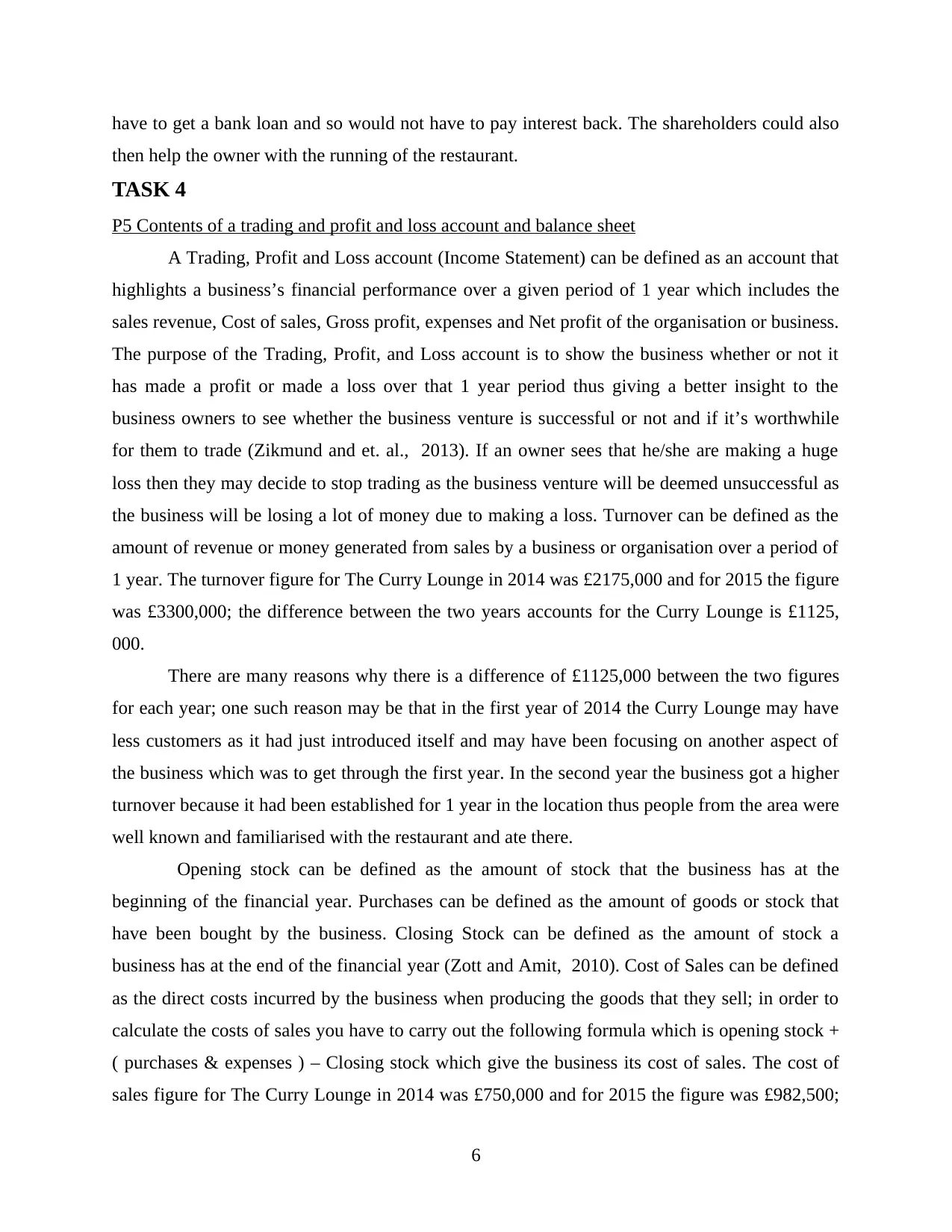
have to get a bank loan and so would not have to pay interest back. The shareholders could also
then help the owner with the running of the restaurant.
TASK 4
P5 Contents of a trading and profit and loss account and balance sheet
A Trading, Profit and Loss account (Income Statement) can be defined as an account that
highlights a business’s financial performance over a given period of 1 year which includes the
sales revenue, Cost of sales, Gross profit, expenses and Net profit of the organisation or business.
The purpose of the Trading, Profit, and Loss account is to show the business whether or not it
has made a profit or made a loss over that 1 year period thus giving a better insight to the
business owners to see whether the business venture is successful or not and if it’s worthwhile
for them to trade (Zikmund and et. al., 2013). If an owner sees that he/she are making a huge
loss then they may decide to stop trading as the business venture will be deemed unsuccessful as
the business will be losing a lot of money due to making a loss. Turnover can be defined as the
amount of revenue or money generated from sales by a business or organisation over a period of
1 year. The turnover figure for The Curry Lounge in 2014 was £2175,000 and for 2015 the figure
was £3300,000; the difference between the two years accounts for the Curry Lounge is £1125,
000.
There are many reasons why there is a difference of £1125,000 between the two figures
for each year; one such reason may be that in the first year of 2014 the Curry Lounge may have
less customers as it had just introduced itself and may have been focusing on another aspect of
the business which was to get through the first year. In the second year the business got a higher
turnover because it had been established for 1 year in the location thus people from the area were
well known and familiarised with the restaurant and ate there.
Opening stock can be defined as the amount of stock that the business has at the
beginning of the financial year. Purchases can be defined as the amount of goods or stock that
have been bought by the business. Closing Stock can be defined as the amount of stock a
business has at the end of the financial year (Zott and Amit, 2010). Cost of Sales can be defined
as the direct costs incurred by the business when producing the goods that they sell; in order to
calculate the costs of sales you have to carry out the following formula which is opening stock +
( purchases & expenses ) – Closing stock which give the business its cost of sales. The cost of
sales figure for The Curry Lounge in 2014 was £750,000 and for 2015 the figure was £982,500;
6
then help the owner with the running of the restaurant.
TASK 4
P5 Contents of a trading and profit and loss account and balance sheet
A Trading, Profit and Loss account (Income Statement) can be defined as an account that
highlights a business’s financial performance over a given period of 1 year which includes the
sales revenue, Cost of sales, Gross profit, expenses and Net profit of the organisation or business.
The purpose of the Trading, Profit, and Loss account is to show the business whether or not it
has made a profit or made a loss over that 1 year period thus giving a better insight to the
business owners to see whether the business venture is successful or not and if it’s worthwhile
for them to trade (Zikmund and et. al., 2013). If an owner sees that he/she are making a huge
loss then they may decide to stop trading as the business venture will be deemed unsuccessful as
the business will be losing a lot of money due to making a loss. Turnover can be defined as the
amount of revenue or money generated from sales by a business or organisation over a period of
1 year. The turnover figure for The Curry Lounge in 2014 was £2175,000 and for 2015 the figure
was £3300,000; the difference between the two years accounts for the Curry Lounge is £1125,
000.
There are many reasons why there is a difference of £1125,000 between the two figures
for each year; one such reason may be that in the first year of 2014 the Curry Lounge may have
less customers as it had just introduced itself and may have been focusing on another aspect of
the business which was to get through the first year. In the second year the business got a higher
turnover because it had been established for 1 year in the location thus people from the area were
well known and familiarised with the restaurant and ate there.
Opening stock can be defined as the amount of stock that the business has at the
beginning of the financial year. Purchases can be defined as the amount of goods or stock that
have been bought by the business. Closing Stock can be defined as the amount of stock a
business has at the end of the financial year (Zott and Amit, 2010). Cost of Sales can be defined
as the direct costs incurred by the business when producing the goods that they sell; in order to
calculate the costs of sales you have to carry out the following formula which is opening stock +
( purchases & expenses ) – Closing stock which give the business its cost of sales. The cost of
sales figure for The Curry Lounge in 2014 was £750,000 and for 2015 the figure was £982,500;
6
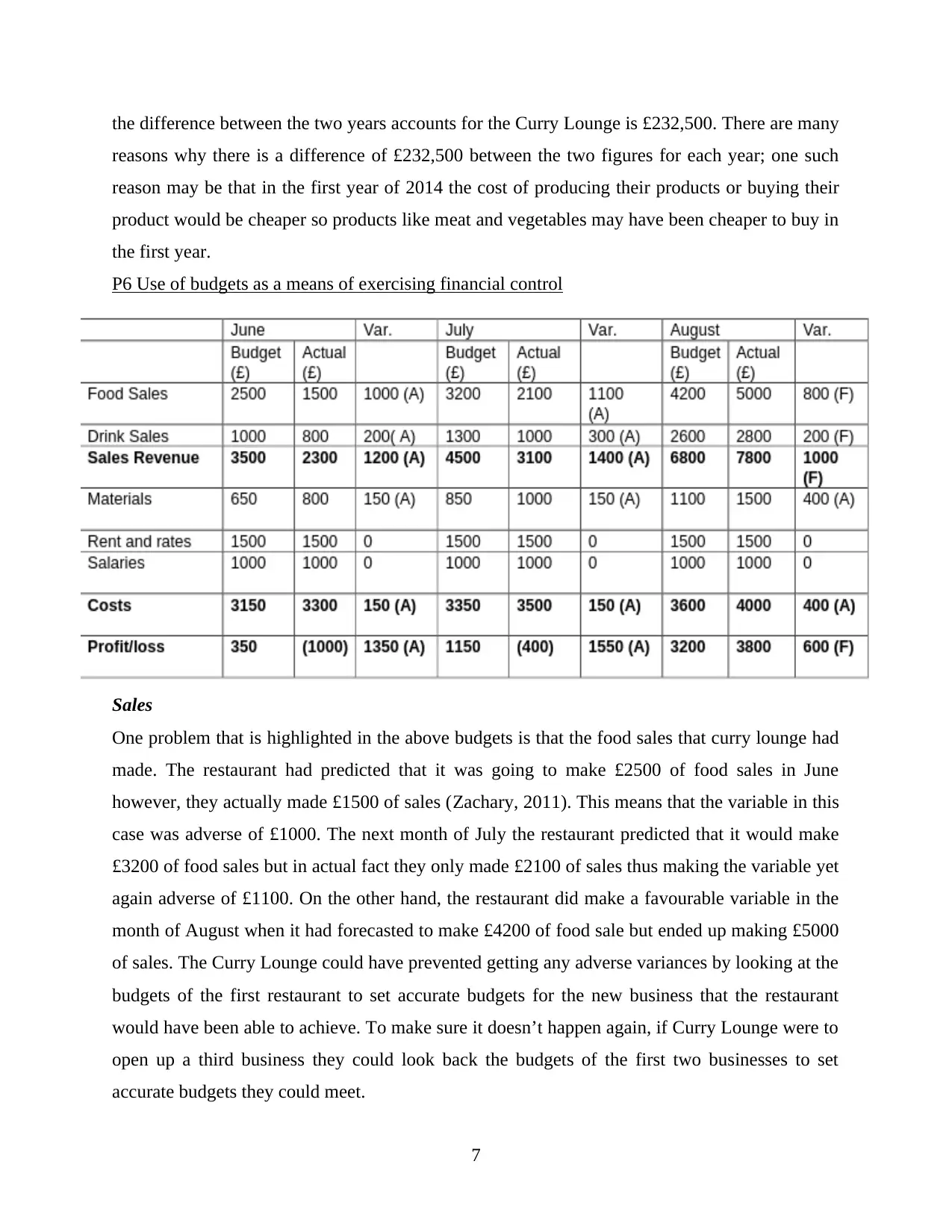
the difference between the two years accounts for the Curry Lounge is £232,500. There are many
reasons why there is a difference of £232,500 between the two figures for each year; one such
reason may be that in the first year of 2014 the cost of producing their products or buying their
product would be cheaper so products like meat and vegetables may have been cheaper to buy in
the first year.
P6 Use of budgets as a means of exercising financial control
Sales
One problem that is highlighted in the above budgets is that the food sales that curry lounge had
made. The restaurant had predicted that it was going to make £2500 of food sales in June
however, they actually made £1500 of sales (Zachary, 2011). This means that the variable in this
case was adverse of £1000. The next month of July the restaurant predicted that it would make
£3200 of food sales but in actual fact they only made £2100 of sales thus making the variable yet
again adverse of £1100. On the other hand, the restaurant did make a favourable variable in the
month of August when it had forecasted to make £4200 of food sale but ended up making £5000
of sales. The Curry Lounge could have prevented getting any adverse variances by looking at the
budgets of the first restaurant to set accurate budgets for the new business that the restaurant
would have been able to achieve. To make sure it doesn’t happen again, if Curry Lounge were to
open up a third business they could look back the budgets of the first two businesses to set
accurate budgets they could meet.
7
reasons why there is a difference of £232,500 between the two figures for each year; one such
reason may be that in the first year of 2014 the cost of producing their products or buying their
product would be cheaper so products like meat and vegetables may have been cheaper to buy in
the first year.
P6 Use of budgets as a means of exercising financial control
Sales
One problem that is highlighted in the above budgets is that the food sales that curry lounge had
made. The restaurant had predicted that it was going to make £2500 of food sales in June
however, they actually made £1500 of sales (Zachary, 2011). This means that the variable in this
case was adverse of £1000. The next month of July the restaurant predicted that it would make
£3200 of food sales but in actual fact they only made £2100 of sales thus making the variable yet
again adverse of £1100. On the other hand, the restaurant did make a favourable variable in the
month of August when it had forecasted to make £4200 of food sale but ended up making £5000
of sales. The Curry Lounge could have prevented getting any adverse variances by looking at the
budgets of the first restaurant to set accurate budgets for the new business that the restaurant
would have been able to achieve. To make sure it doesn’t happen again, if Curry Lounge were to
open up a third business they could look back the budgets of the first two businesses to set
accurate budgets they could meet.
7
⊘ This is a preview!⊘
Do you want full access?
Subscribe today to unlock all pages.

Trusted by 1+ million students worldwide
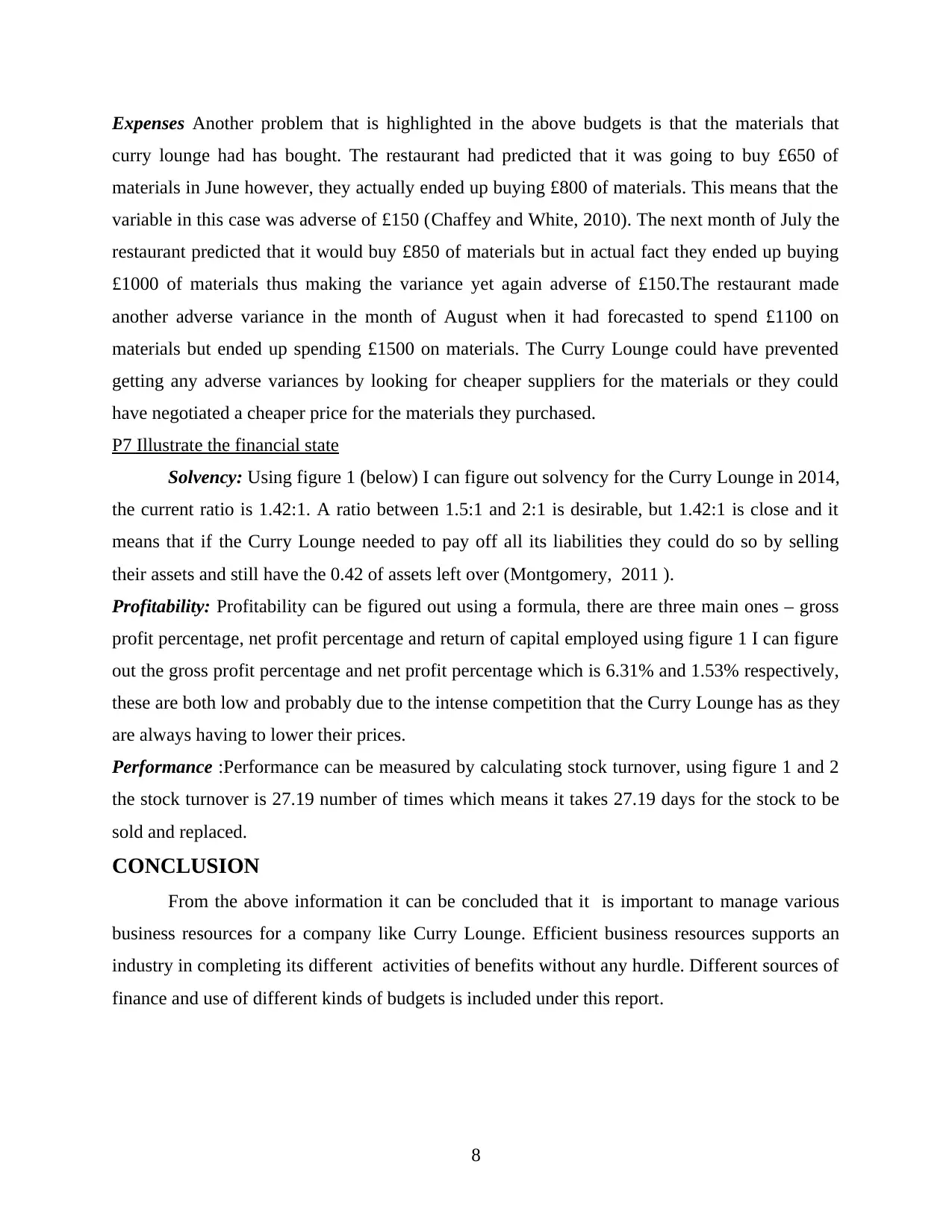
Expenses Another problem that is highlighted in the above budgets is that the materials that
curry lounge had has bought. The restaurant had predicted that it was going to buy £650 of
materials in June however, they actually ended up buying £800 of materials. This means that the
variable in this case was adverse of £150 (Chaffey and White, 2010). The next month of July the
restaurant predicted that it would buy £850 of materials but in actual fact they ended up buying
£1000 of materials thus making the variance yet again adverse of £150.The restaurant made
another adverse variance in the month of August when it had forecasted to spend £1100 on
materials but ended up spending £1500 on materials. The Curry Lounge could have prevented
getting any adverse variances by looking for cheaper suppliers for the materials or they could
have negotiated a cheaper price for the materials they purchased.
P7 Illustrate the financial state
Solvency: Using figure 1 (below) I can figure out solvency for the Curry Lounge in 2014,
the current ratio is 1.42:1. A ratio between 1.5:1 and 2:1 is desirable, but 1.42:1 is close and it
means that if the Curry Lounge needed to pay off all its liabilities they could do so by selling
their assets and still have the 0.42 of assets left over (Montgomery, 2011 ).
Profitability: Profitability can be figured out using a formula, there are three main ones – gross
profit percentage, net profit percentage and return of capital employed using figure 1 I can figure
out the gross profit percentage and net profit percentage which is 6.31% and 1.53% respectively,
these are both low and probably due to the intense competition that the Curry Lounge has as they
are always having to lower their prices.
Performance :Performance can be measured by calculating stock turnover, using figure 1 and 2
the stock turnover is 27.19 number of times which means it takes 27.19 days for the stock to be
sold and replaced.
CONCLUSION
From the above information it can be concluded that it is important to manage various
business resources for a company like Curry Lounge. Efficient business resources supports an
industry in completing its different activities of benefits without any hurdle. Different sources of
finance and use of different kinds of budgets is included under this report.
8
curry lounge had has bought. The restaurant had predicted that it was going to buy £650 of
materials in June however, they actually ended up buying £800 of materials. This means that the
variable in this case was adverse of £150 (Chaffey and White, 2010). The next month of July the
restaurant predicted that it would buy £850 of materials but in actual fact they ended up buying
£1000 of materials thus making the variance yet again adverse of £150.The restaurant made
another adverse variance in the month of August when it had forecasted to spend £1100 on
materials but ended up spending £1500 on materials. The Curry Lounge could have prevented
getting any adverse variances by looking for cheaper suppliers for the materials or they could
have negotiated a cheaper price for the materials they purchased.
P7 Illustrate the financial state
Solvency: Using figure 1 (below) I can figure out solvency for the Curry Lounge in 2014,
the current ratio is 1.42:1. A ratio between 1.5:1 and 2:1 is desirable, but 1.42:1 is close and it
means that if the Curry Lounge needed to pay off all its liabilities they could do so by selling
their assets and still have the 0.42 of assets left over (Montgomery, 2011 ).
Profitability: Profitability can be figured out using a formula, there are three main ones – gross
profit percentage, net profit percentage and return of capital employed using figure 1 I can figure
out the gross profit percentage and net profit percentage which is 6.31% and 1.53% respectively,
these are both low and probably due to the intense competition that the Curry Lounge has as they
are always having to lower their prices.
Performance :Performance can be measured by calculating stock turnover, using figure 1 and 2
the stock turnover is 27.19 number of times which means it takes 27.19 days for the stock to be
sold and replaced.
CONCLUSION
From the above information it can be concluded that it is important to manage various
business resources for a company like Curry Lounge. Efficient business resources supports an
industry in completing its different activities of benefits without any hurdle. Different sources of
finance and use of different kinds of budgets is included under this report.
8
Paraphrase This Document
Need a fresh take? Get an instant paraphrase of this document with our AI Paraphraser
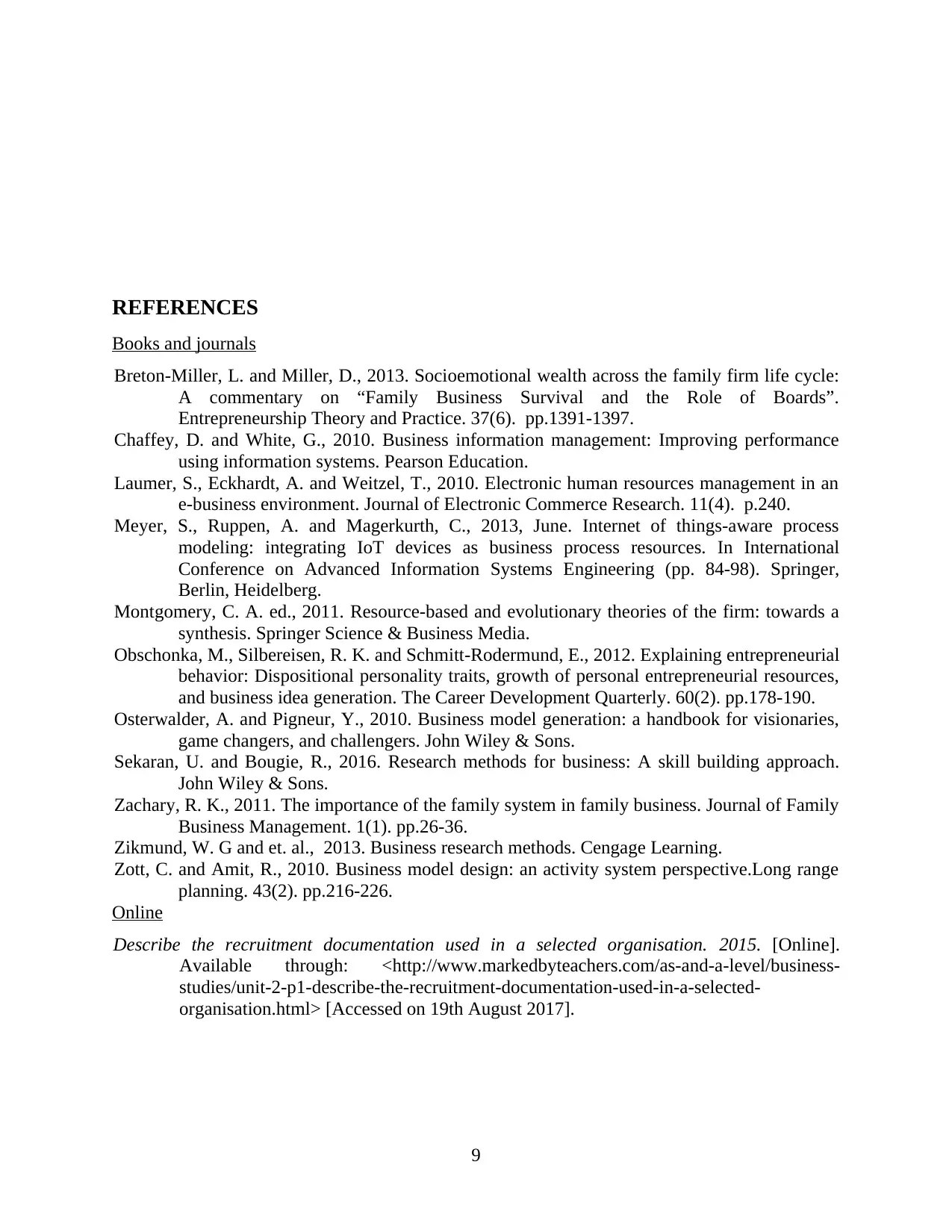
REFERENCES
Books and journals
Breton‐Miller, L. and Miller, D., 2013. Socioemotional wealth across the family firm life cycle:
A commentary on “Family Business Survival and the Role of Boards”.
Entrepreneurship Theory and Practice. 37(6). pp.1391-1397.
Chaffey, D. and White, G., 2010. Business information management: Improving performance
using information systems. Pearson Education.
Laumer, S., Eckhardt, A. and Weitzel, T., 2010. Electronic human resources management in an
e-business environment. Journal of Electronic Commerce Research. 11(4). p.240.
Meyer, S., Ruppen, A. and Magerkurth, C., 2013, June. Internet of things-aware process
modeling: integrating IoT devices as business process resources. In International
Conference on Advanced Information Systems Engineering (pp. 84-98). Springer,
Berlin, Heidelberg.
Montgomery, C. A. ed., 2011. Resource-based and evolutionary theories of the firm: towards a
synthesis. Springer Science & Business Media.
Obschonka, M., Silbereisen, R. K. and Schmitt‐Rodermund, E., 2012. Explaining entrepreneurial
behavior: Dispositional personality traits, growth of personal entrepreneurial resources,
and business idea generation. The Career Development Quarterly. 60(2). pp.178-190.
Osterwalder, A. and Pigneur, Y., 2010. Business model generation: a handbook for visionaries,
game changers, and challengers. John Wiley & Sons.
Sekaran, U. and Bougie, R., 2016. Research methods for business: A skill building approach.
John Wiley & Sons.
Zachary, R. K., 2011. The importance of the family system in family business. Journal of Family
Business Management. 1(1). pp.26-36.
Zikmund, W. G and et. al., 2013. Business research methods. Cengage Learning.
Zott, C. and Amit, R., 2010. Business model design: an activity system perspective.Long range
planning. 43(2). pp.216-226.
Online
Describe the recruitment documentation used in a selected organisation. 2015. [Online].
Available through: <http://www.markedbyteachers.com/as-and-a-level/business-
studies/unit-2-p1-describe-the-recruitment-documentation-used-in-a-selected-
organisation.html> [Accessed on 19th August 2017].
9
Books and journals
Breton‐Miller, L. and Miller, D., 2013. Socioemotional wealth across the family firm life cycle:
A commentary on “Family Business Survival and the Role of Boards”.
Entrepreneurship Theory and Practice. 37(6). pp.1391-1397.
Chaffey, D. and White, G., 2010. Business information management: Improving performance
using information systems. Pearson Education.
Laumer, S., Eckhardt, A. and Weitzel, T., 2010. Electronic human resources management in an
e-business environment. Journal of Electronic Commerce Research. 11(4). p.240.
Meyer, S., Ruppen, A. and Magerkurth, C., 2013, June. Internet of things-aware process
modeling: integrating IoT devices as business process resources. In International
Conference on Advanced Information Systems Engineering (pp. 84-98). Springer,
Berlin, Heidelberg.
Montgomery, C. A. ed., 2011. Resource-based and evolutionary theories of the firm: towards a
synthesis. Springer Science & Business Media.
Obschonka, M., Silbereisen, R. K. and Schmitt‐Rodermund, E., 2012. Explaining entrepreneurial
behavior: Dispositional personality traits, growth of personal entrepreneurial resources,
and business idea generation. The Career Development Quarterly. 60(2). pp.178-190.
Osterwalder, A. and Pigneur, Y., 2010. Business model generation: a handbook for visionaries,
game changers, and challengers. John Wiley & Sons.
Sekaran, U. and Bougie, R., 2016. Research methods for business: A skill building approach.
John Wiley & Sons.
Zachary, R. K., 2011. The importance of the family system in family business. Journal of Family
Business Management. 1(1). pp.26-36.
Zikmund, W. G and et. al., 2013. Business research methods. Cengage Learning.
Zott, C. and Amit, R., 2010. Business model design: an activity system perspective.Long range
planning. 43(2). pp.216-226.
Online
Describe the recruitment documentation used in a selected organisation. 2015. [Online].
Available through: <http://www.markedbyteachers.com/as-and-a-level/business-
studies/unit-2-p1-describe-the-recruitment-documentation-used-in-a-selected-
organisation.html> [Accessed on 19th August 2017].
9

10
⊘ This is a preview!⊘
Do you want full access?
Subscribe today to unlock all pages.

Trusted by 1+ million students worldwide
1 out of 12
Related Documents
Your All-in-One AI-Powered Toolkit for Academic Success.
+13062052269
info@desklib.com
Available 24*7 on WhatsApp / Email
![[object Object]](/_next/static/media/star-bottom.7253800d.svg)
Unlock your academic potential
Copyright © 2020–2025 A2Z Services. All Rights Reserved. Developed and managed by ZUCOL.





